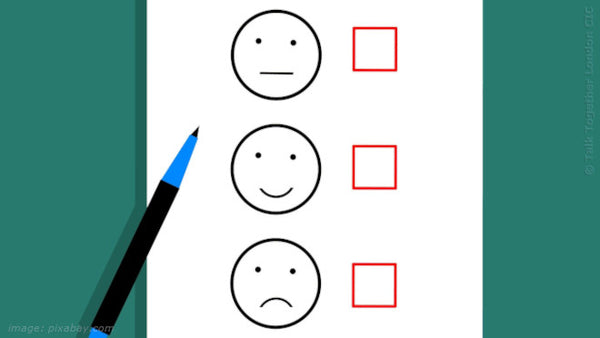What is the negativity bias?
The negativity bias is our tendency to register negative stimuli more readily and to form our perceptions, behaviour and actions on the basis of this experience.
In this post, you will learn:
How to spot the negativity bias?
What does research say about the negativity bias?
Why mindfulness of the negativity bias matters?
How to nurture a more balanced outlook?
Conclusion: the transformation
Consider what this could mean for you, your loved ones and your career and let's begin:

Introduction: How to spot the negativity bias?
The negativity bias can take a toll on our mental health. Research shows that negative information draws our attention. But, the negativity bias is more than a tendency to register negative stimuli more readily, because we also form our perceptions, behaviour and actions on the basis of this unconscious attention that we devote to negative stimuli, events or feedback.
For example, not only do we pay more attention to negative criticism, but we also feel the sting of criticism more powerfully than we feel the joy of praise. Negative comments hold more sway than positive ones and take up more room in our memory, too. This is why we must focus on being respectful, even during arguments, as no one would like to say something others will recall years later and they will regret.
Also, this aspect of negativity bias - known as positive-negative asymmetry - means that we have less motivation when a reward is framed as a means to gain something than when the same reward is framed as a means to help us avoid the loss of something.
So, this bias may seriously impair our judgements and how we evaluate our lives, too. Here is an example* of how it may influence your thoughts, feelings and behaviour:
A company is making a small profit. It is located in a community experiencing a recession with substantial unemployment but no inflation. The company decides to decrease wages and salaries 7 percent this year. How do people judge it? 'Acceptable' 37 percent but 'Unfair' 63 percent.
A company is making a small profit. It is located in a community experiencing a recession with substantial unemployment and inflation of 12 percent. The company decides to increase salaries only 5 percent this year. How do people judge it? 'Acceptable' 78 percent and 'Unfair' 22 percent. The reserachers conclude that: "In this case a 7 percent cut in real wages is judged reasonably fair when it is framed as a nominal wage increase, but quite unfair when it is posed as a nominal wage cut."*
In the world of media, bad news sells more and many stories depict negative events and turmoil. When taken in conjunction with the results of laboratory-based experiments, this backs up the notion that negative information generally has a stronger pull on attention and memory than does positive information.
During the lockdown Hayley (not her real name) noticed how she easily believed every piece of negative news as truthful but questioned any snippet of good news as invalid. Her mind was lingering over the worst-case scenarios in extreme detail without even considering the possibility of better outcomes or best-case scenarios.
Negativity bias can affect the quality of our lives by making it difficult to maintain a balanced outlook, as it did Hayley's, causing her to be engrossed in dark thoughts and hurting her relationships with friends, neighbours and loved ones.
Hayley found herself dwelling on her own mistakes and fixating on criticism. She began to perceive any advice or suggestion as a rebuke or insult and these had a greater impact on her than compliments. The fear of getting negative feedback was winning over the pleasure of completing anything.

Science: What does research say about the negativity bias?
Understanding how our brain is so vigilant and cautious, and so easily commandeered by alarm, is the first step toward gaining more control over our negativity bias. A number of studies have suggested that negativity attracts attention magnet like a magnet.
First of all, negativity has a measurable effect on your blinking rates and increases in pupil diameter, heart rate and peripheral arterial tone. But, a number of other studies show that negativity has other far reaching effects.
Even when the emotional nature or content of stimuli is not relevant to a task that we are undertaking, human beings tend to give preferential attendance to negative information. This special attendance is termed 'automatic vigilance hypothesis' by researchers. The hypothesis was investigated by using a Stroop task.
The Stroop task is a famous attention task in cognitive psychology. In the original Stroop task, participants were presented a list of words that were written in different ink colours:

Stroop test (Image credit: BBC)
They had to report to the experimenter the colour words were written in, in other words, their ink colour. To achieve the task it was essential for the participants to consciously move their attention away from the meaning of the words and to focus on the ink colour of the words.
In the emotional Stroop task, participants were shown words like these and asked to tell the experimenter the colour of each word, but, in this modified version of the Stroop task, the experimenters presented a series of negative and positive personality traits written in several different ink colours to people and the participants had to name the colour of each word quickly as each trait appeared on a screen.
The positive and negative connotations of the words were not relevant to the colour naming task of the emotional Stroop task. Nevertheless, people took more time to name the colour of negative traits than they did positive traits. This difference in response time indicated that greater attention was devoted to processing the trait itself when it was negative.
It also suggested that, as predicted by the automatic vigilance hypothesis, more accompanying learning for undesirable traits took place: in other words, people remembered more negative trait words than positive trait words.
The emotional Stroop test investigates one of the functions of automatic stimulus evaluation to direct attention toward events that may have undesirable consequences for the perceiver's well-being. Participants taking the tests named the colours in which desirable and undesirable traits appeared on a screen: for example, honest, sadistic. The results showed that our resources of attention and memory are automatically directed away from an attended task to undesirable stimuli.

Challenge: Why mindfulness of the negativity bias matters?
Negativity bias matters because in most situations, we experience negative events as more significant, powerful, dominant in combinations, and generally efficacious than positive events. Researchers found that a positive attitude or positive emotion does not have an effect on measured behaviour oppositely equivalent to the effect of a negative attitude or negative emotion.
Negativity bias plays a significant role in many parts of our lives: sensory, memory, influence, impressions of persons, moral judgments, and so on. According to negativity bias research, there is a great deal of evidence in support of the notion that negativity bias is a pervasive and consequential feature of human existence. Therefore, it is vital to be mindful of how the negativity bias works and our brains prefer biases to facts or hard evidence.
When we understand what it is, we may then take precautions in order to mitigate its harmful results. Scientists suggest that the negativity bias evolved as a survival technique. It can be helpful as well. For example, expecting that a negative situation may turn out to be harmful for us at the present time is much safer than assuming that it will not pose a danger to our survival or well-being.
In order to survive, organisms must be most efficient at dealing with both the most frequent occurrences and the most important occurrences in their lives. Positive occurrences happen with greater frequency, but they have less urgency. Negative events, on the other hand, may be less frequent, but they have importance in the sense that they are urgent because they may pose an immediate threat to our wellbeing or survival.
As a survival technique, the negativity bias also seems to influence how we learn from life’s events. Researchers have documented that both animals and human beings learn more quickly from experiencing negative events than positive events. For example, we learn not to touch a burning stove from a single experience of burning a finger. But, rewards do not bring about a similar behaviour change: for example, if there is a food that you do not like to eat, rewards are unlikely to cause a change of mind and convince you to eat that food.
So, this cognitive bias affects us in a number of ways in modern life, both in constructive and damaging ways. As an unconscious occurrence, we may not recognize these effects, but studies have shown the negativity bias to be ever-present in our behaviours.
So, to summarize, we are usually not conscious of the workings of the negativity bias in our lives, but scientists have found through extensive research that it is a bias present in the behaviour of both animals and human beings. It can play both a constructive and a damaging role in our lives.
In the next section we will look at some of the areas that the negativity bias may influence us in an unhelpful way and explore how to minimise the damage.

Goal: How to nurture a more balanced outlook?
The negativity bias may appear in our lives in different ways. It can have a powerful impact on our thoughts, feelings and behaviour. Being aware of its workings means that you can consciously adopt strategies to have a more balanced outlook on your life.
The different aspects of the negativity bias were first studied and described by researchers Rozin and Royzman in 2001. If we want to nurture a more balanced outlook, here are the four aspects of the negativity bias to be aware of - below we explain each aspect with an example to show how it works in real life.
Negative potency:
We give a negative event or object more subjective weight than an equally positive event or object. For example, criticism is more likely to be remembered than praise.
Negative gradients:
We regard negative events as more negative when we are approaching them while, in contrast, we do not experience a similar increase in feelings of positivity when we are approaching positive events in space or time. Positive and negative events will create more and more emotion in us as they come closer, but the feelings will be stronger with negative events than positive ones.
For example, compare an exam and a party that will take place in the near future: the feelings of worry and anxiety that we feel about the exam are going to increase more steeply than the joy and happiness we feel about the party as we get closer to attending these events.
Negativity dominance:
In a situation which has both negative and positive features, we will regard the situation as a whole as more negative than positive. There are two types of examples to demonstrate this aspect of negativity bias.
One type of dominance would be evaluating a person’s character traits on the basis of a list of adjectives describing negative and positive traits: the negative traits will be disproportionately more influential in determining the overall appraisal of the person than the positive components of the list.
Another type is how a brief contact with an insect like a fly will render a platter of food inedible: in other words, in this case the effect of the negativity bias is much more than influencing an evaluation. The combination of something negative with something; positive is making the whole thing become negative.
Negative differentiation:
Our cognition and vocabulary for negative occurrences is more complex, elaborated and fine tuned than the corresponding positive phenomenon. Researchers suggest that this may be because our response options to negative events can not be as straightforward as to positive events: they have to be more varied as we consider fighting, fleeing, withdrawing slowly or freezing.
So, what can you do to take steps toward a more balanced outlook? The answer is not simple because there is also evidence of a bias called the ‘positivity bias’ that researchers know about.
Let’s put it this way: replacing negativity with positivity does not ensure that we will have a more balanced outlook in life. So, what can we do? The answer is we can be aware of how biases in general and the negativity bias in particular work and take precautions.
What are the steps we can take to ensure a more balanced outlook? Well, we must first of all, to repeat, develop awareness and mindfulness. Accept that you have a tendency to change your thought processes and behaviours much more because of negative things than you do because of neutral or positive things. This tendency protects you from danger but as an irrational bias it may also cause harm to relationships, careers, finances and mental health.
You can then proceed to develop a tool box of skills so that the negativity bias does not cause damage:
- Negative self-talk:
Stopping our tendency towards negative self-talk throughout the day about ourselves and others prevents us from developing cycles of negativity.
- Reframing situations:
Now that we know how negativity grabs our attention and memory, we can make sure that we are giving equal and fair weight to every aspect of a situation whether negative, positive or neutral.
- Develop new patterns:
The negativity bias is part of our make up as human beings and we can not get rid of it, but what we can do is to establish some new patterns of behaviour in our lives so that we are not overwhelmed by negativity. So, we can take a step back to reflect by making room in our daily schedule for exercise, relaxation, mindfulness and meditation and similar activities, especially before major decisions.
- Appreciate the good things in your life:
Not only do negative occurrences grab your attention more but they also are remembered more than positive occurrences. That is to say, it takes more for positive occurrences or events to be remembered; in other words, we hardly notice them and even if we do we will hardly recall them later. So, when something positive happens, make a note of it and try to keep a gratitude diary of all the good and positive people, things and events in your life.
- Monitor how you’re feeling:
Controlling impulsive behaviour triggered by feelings and emotions can help to keep the negativity bias in check. So, pause and ask yourself whether you are feeling tired or hungry or upset. If you are feeling weak or vulnerable, you will be more susceptible to self-destructive behaviours because the negativity bias forces people to make poor and unreasonable decisions.

Conclusion: the transformation
To ensure a rational decision, we must: (1) define the situation, (2) identify the criteria necessary to judge the multiple options, (3) weight the criteria and rank them in terms of importance to us, (4) generate alternatives, (5) rate each alternative on each criterion, and (6) calculate the optimal decision.
When Hayley took some time out, she realised that everyday she was making countless decisions for herself, her family and her job: what to wear, where to work, how to reply to an email, what to prepare for dinner, which meeting to attend on Zoom, who to contact and many others. The quality of some of her decisions were rational and some were not.
Hayley noticed that sometimes she was going with her gut and had reliable intuitions in predictable situations where opportunities for learning existed. However, success eluded her when she took shortcuts and went with the first satisfactory course of action rather than continuing to search for the best.
As human beings we try to make rational decisions by weighing the pros and cons of a choice but our cognitive limitations prevent us from being fully rational. Time and cost restrictions limit the quantity and quality of the information that is available to us.
In addition, we can only keep a relatively small amount of information in our usable memory. And also we have limitations on our intelligence and perceptions so that the ability of even very bright people to accurately make the best choices based on the available information is imperfect.
So, she took time out to consider past situations and reflected on the following questions: How did she make her decisions? What obstacles did she have and how did she overcome them? What were the results and what did she learn? Answering these questions helped her to reframe each scenario. She developed a guide in making informed decisions. And most importantly, she accepted herself and stopped the negative self-talk which was needlessly pulling her down and fuelling her natural tendency for negativity.
Endnotes:
* Anomalies: The Endowment Effect, Loss Aversion, and Status Quo Bias by Daniel Kahneman, Jack L. Knetsch, Richard H. Thaler The Journal of Economic Perspectives, 5(1), pp. 193-206, Winter 1991
References:
https://www.bbc.co.uk/blogs/theoneshow/onepassions/2009/02/body-tricks-stroop-test.html
Kahneman, Daniel; Knetsch, Jack L. ; Thaler, Richard H. (1991) Anomalies: The Endowment Effect, Loss Aversion, and Status Quo Bias. The Journal of Economic Perspectives, 5(1), pp. 193-206, Winter 1991
Pratto, F., & John, O. P. (1991). Automatic vigilance: The attention-grabbing power of negative social information. Journal of Personality and Social Psychology, 61(3), 380–391. https://doi.org/10.1037/0022-3514.61.3.380
Rozin, Paul; Royzman, Edward B. (2001). Negativity bias, negativity dominance, and contagion. Personality and Social Psychology Review, 5 (4): 296–320. https://doi.org/10.1207/S15327957PSPR0504_2


